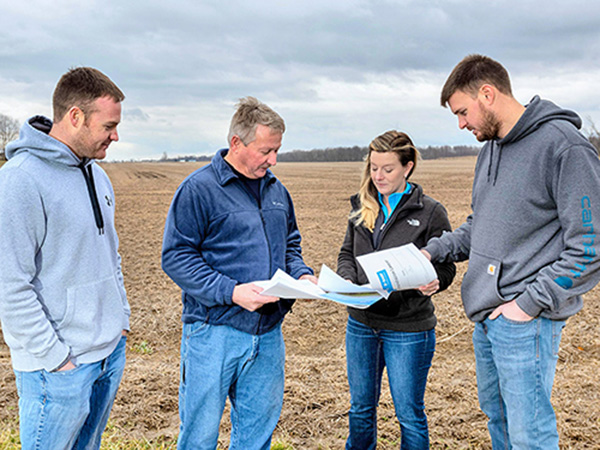Welcome to the 2019 BASF Innovations in the Field. This yearlong program is designed to showcase four progressive farmers and their use of technology and agronomic practices to enhance their return on investment and profit potential. Check back each week as the farmers share their experiences and crop management decisions throughout the growing season.

Besides a wet fall harvest, 2018 was one of the best growing seasons ever for B&M Farms, located in Pendleton, Indiana, bringing high corn yields. When it comes to soybeans, though, each year is different, and the Robinson family knows this firsthand.
Ryan and Nick Robinson, along with their uncle Mike Lawyer, who owns B&M Farms, have felt the aftermath of soybean yield fluctuation. What seemed to be a good soybean crop had late infestation of stink bug and frogeye leaf spot, taking 10 or so bushels per acre off the final yield in several untreated fields.
B&M Farms knew that in order to boost soybean yields, they needed to test new production practices. The farm worked with their BASF Innovation Specialist, Melanie Burk, to try out some new techniques. They include:
1. APPLYINGN SULFUR: "We plan to apply sulfur on half our 2019 soybean acres," says Lawyer. "We'll use AMS (ammonium sulfate) as it's a little more economical for us than a liquid program," he explains. The family ran a strip trial with AMS in 2018 and saw enough good results to convince them it was a good idea to expand sulfur application acreage in 2019.
2. PLANTING EARLIER: Weather permitting, the family is looking at planting some soybeans in early to mid-April, a good 10 days to two weeks earlier than normal. Planting soybeans earlier could contribute to higher yields. "Moving the planting date up extends the flowering window and potentially produces a crop that matures before late-season disease and insect pressure," notes Burk. Lawyer recalls that early mid-group soybeans were their best yielding soybeans the past three years. "This past year," he adds, "yields on any soybeans planted after May 15 started falling off." Lawyer also likes the fact that early beans can be harvested earlier, spreading out the fall harvest workload.
3. LOWER SEEDING RATE: The family is also looking at lowering their soybean seeding rate from the 150,000 they've been using. "Reducing seeding rate is one thing we can do to lower seed cost," notes Lawyer. BASF's Melanie Burk recommends they run trials seeding at 110,000, 130,000 and 150,000 seeds per acre and compare. Burk also recommends testing different rates with both later-planted and early beans.
4. NEW FUNGICIDE: The family is already a big believer in making corn and soybean fungicide applications. In 2018, they applied Headline AMP® fungicide on corn and Priaxor®, fungicide on soybeans, with good results. The Priaxor fungicide application was made in late July when beans were at R2 to R3 stages. The benefit of applying fungicides in soybeans in 2018 was especially evident in a fungicide test plot with untreated strips. Both Priaxor fungicide and another fungicide were applied to the treated strips. "The results were so obvious I could see the difference between the fungicide-treated and the untreated strips out of the side of my eye driving down the road at 50 miles an hour," notes Ryan Robinson. A late-season infestation of frogeye leaf spot was the main yield-robbing culprit. The untreated soybeans yielded almost 10 bushels per acre less than soybeans treated with a fungicide. In anticipation of BASF's new fungicide being approved by the EPA this year, Burk hopes to provide the family with the fungicide for a 2019 trial.
5. VARY SEED TREATMENT: The family started treating their own soybean seed in 2018. This enabled them to change seed treatment for different planting conditions as seed was sent to the field for planting. The family is looking at possibly setting up trials to compare seed treatments. "We might test the seed treatment ILeVO® to control sudden death syndrome (SDS) and nematodes on some seed," says Lawyer. Burk recommends targeting ILeVO seed treatment on soybean varieties susceptible to SDS and in fields where nematode pressure is high. Treating their soybean seed gives the family several advantages besides being able to tailor seed treatment to conditions. One is economic. Over time they expect to see significant savings over buying treated seed, considering the amount of soybean seed they plant. The other is having fresh seed treatment. "Many seed treatments decline in effectiveness over time," notes Burk. Treated soybeans delivered in February and not planted until May can be more than three months old before being put in the ground. With their own seed treater, Ryan Robinson treats seed right before it's taken to the field. The family plants only Liberty® herbicide-resistant soybeans. Weed control has not been a problem for them, although, as with most growers in the area, they have increased their use of residual herbicides to better control waterhemp and other weeds until canopy.